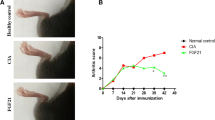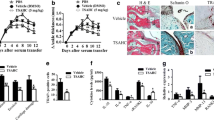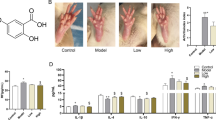Abstract
Epidermal growth factor receptor (EGFR) and its ligands are commonly expressed by synovial cells. The aim of the present study was to detect the potential effect of lapatinib an inhibitor of EGFR tyrosine kinases on collagen-induced arthritis. Thirty Wistar albino female rats were randomized into three groups. Arthritis was induced by intradermal injection of chicken type II collagen with incomplete Freund’s adjuvant. Serum TNF-α, IL-17, and malondialdehyde (MDA) levels were analyzed. Tissue superoxide dismutase (SOD), catalase and glutathione peroxidase (GPx) activities, and nuclear factor erythroid 2-related factor-2 (Nrf2) and heme oxgenase-1 (HO-1) expressions were determined. TNF-α, IL-17 and MDA levels, and Nrf2 and HO-1 expressions were lower in lapatinib-treated (30 mg/kg/day) group compared to sham group, while SOD, catalase, and GPx activities were higher (p < 0.05). Moreover, lapatinib ameliorated perisynovial inflammation and cartilage–bone destruction (p < 0.001). In conclusion, EGFR may have prominent pathogenic role and lapatinib may be an effective therapeutic option for arthritis.




Similar content being viewed by others
References
Hirohata, S., and J. Sakakibara. 1999. Angioneogenesis as a possible elusive triggering factor in rheumatoid arthritis. Lancet 353: 1331.
Pap, T., and O. Distler. 2005. Linking angiogenesis to bone destruction in arthritis. Arthritis and Rheumatism 52: 1346–1348.
Clavel, G., N. Bessis, and M.C. Boissier. 2003. Recent data on the role for angiogenesis in rheumatoid arthritis. Joint, Bone, Spine 70: 321–326.
Nagashima, M., H. Tanaka, H. Takahashi, A. Tachihara, K. Tanaka, T. Ishiwata, et al. 2002. Study of the mechanism involved in angiogenesis and synovial cell proliferation in human synovial tissues of patients with rheumatoid arthritis using SCID mice. Laboratory Investigation 82: 981–988.
Sone, H., Y. Kawakami, M. Sakauchi, Y. Nakamura, A. Takahashi, H. Shimano, et al. 2001. Neutralization of vascular endothelial growth factor prevents collagen-induced arthritis and ameliorates established disease in mice. Biochemical and Biophysical Research Communications 281: 562–568.
Kusada, J., T. Otsuka, N. Matsui, T. Hirano, K. Asai, and T. Kato. 1993. Immuno-reactive human epidermal growth factor (h-EGF) in rheumatoid synovial fluids. Nippon Seikeigeka Gakkai Zasshi 67: 859–865.
Satoh, K., S. Kikuchi, M. Sekimata, Y. Kabuyama, M.K. Homma, and Y. Homma. 2001. Involvement of ErbB-2 in rheumatoid synovial cell growth. Arthritis and Rheumatism 44: 260–265.
Perrotte, P., T. Matsumoto, K. Inoue, H. Kuniyasu, B.Y. Eve, D.J. Hicklin, et al. 1999. Anti-epidermal growth factor receptor antibody C225 inhibits angiogenesis in human transitional cell carcinoma growing orthotopically in nude mice. Clinical Cancer Research 5: 257–265.
Goldman, C.K., J. Kim, W.L. Wong, V. King, T. Brock, and Gillespie. 1993. Epidermal growth factor stimulates vascular endothelial growth factor production by human malignant glioma cells: a model of glioblastoma multiforme pathophysiology. Molecular Biology of the Cell 4: 121–133.
Zhang, Z., T. Song, Y. Jin, J. Pan, L. Zhang, L. Wang, and P. Li. 2009. Epidermal growth factor receptor regulates MT1-MMP and MMP-2 synthesis in SiHa cells via both PI3-K/AKT and MAPK/ERK pathways. International Journal of Gynecological Cancer 19: 998–1003.
Kim, H.P., Y.K. Yoon, J.W. Kim, S.W. Han, H.S. Hur, J. Park, et al. 2009. Lapatinib, a dual EGFR and HER2 tyrosine kinase inhibitor, downregulates thymidylate synthase by inhibiting the nuclear translocation of EGFR and HER2. PloS One 16: 5933.
Rusnak, D.W., K. Lackey, K. Affleck, E.R. Wood, K.J. Alligood, N. Rhodes, et al. 2001. The effects of the novel, reversible epidermal growth factor receptor/ErbB-2 tyrosine kinase inhibitor, GW2016, on the growth of human normal and tumor-derived cell lines in vitro and in vivo. Molecular Cancer Therapeutics 1: 85–94.
Hirata, A., S. Ogawa, T. Kometani, T. Kuwano, S. Naito, M. Kuwano, et al. 2002. ZD1839 (Iressa) induces antiangiogenic effects through inhibition of epidermal growth factor receptor tyrosine kinase. Cancer Research 62: 2554–2260.
Trentham, D.E., A.S. Townes, and A.H. Kang. 1977. Autoimmunity to type II collagen an experimental model of arthritis. The Journal of Experimental Medicine 146: 857–868.
Hoffmann, M.S., S. Hayer, and G. Steiner. 2009. Immmunopathogenesis of rheumatoid arthritis; induction of arthritogenic autoimmune responses by proinflammatory stimuli. Annals of the New York Academy of Sciences 1173: 391–400.
Larsson, P., S. Kleinau, R. Holmdahl, and L. Klareskog. 1990. Homologous type II collagen-induced arthritis in rats. Characterization of the disease and demonstration of clinically distinct forms of arthritis in two strains of rats after immunization with the same collagen preparation. Arthritis and Rheumatism 33: 693–701.
Choi, J., B.J. Yoon, Y.N. Han, K.T. Lee, J. Ha, H.J. Jung, and H.J. Park. 2003. Antirheumatoid arthritis effect of rhus verniciflua and of the active component, sulfuretin. Planta Medica 69: 899–904.
Lowry, O.H., N.J. Rosebrough, A.L. Farr, and R.J. Randall. 1951. Protein measurement with the folin phenol reagent. Journal of Biological Chemistry 193: 165–175.
Yamane, S., S. Ishida, Y. Hanamoto, K. Kumagai, R. Masuda, K. Tanaka, et al. 2008. Proinflammatory role of amphiregulin, an epidermal growth factor family member whose expression is augmented in rheumatoid arthritis patients. Journal of Inflammation 5: 5.
Swanson, C.D., E.H. Akama-Garren, E.A. Stein, J.D. Petralia, P.J. Ruiz, A. Edalati, T.M. Lindstrom, and W.H. Robinson. 2012. Inhibition of epidermal growth factor receptor tyrosine kinase ameliorates collagen-induced arthritis. Journal of Immunology 188: 3513–3521.
Li, X., F.L. Yuan, W.G. Lu, Y.Q. Zhao, C.W. Li, J.P. Li, and R.S. Xu. 2010. The role of interleukin-17 in mediating joint destruction in rheumatoid arthritis. Biochemical and Biophysical Research Communications 397: 131–135.
Van Bezooijen, R.L., L. Van Der Wee-Pals, S.E. Papapoulos, and C.W. Löwik. 2002. Interleukin 17 synergises with tumour necrosis factor alpha to induce cartilage destruction in vitro. Annals of the Rheumatic Diseases 61: 870–876.
Koenders, M.I., J.K. Kolls, B. Oppers-Walgreen, L. van den Bersselaar, L.A. Joosten, J.R. Schurr, et al. 2005. Interleukin-17 receptor deficiency results in impaired synovial expression of interleukin-1 and matrix metalloproteinases 3, 9, and 13 and prevents cartilage destruction during chronic reactivated streptococcal cell wall-induced arthritis. Arthritis and Rheumatism 52: 3239–3247.
Kamiya, S., C. Nakamura, T. Fukawa, K. Ono, T. Ohwaki, T. Yoshimoto, et al. 2007. Effects of IL-23 and IL-27 on osteoblasts and osteoclasts: inhibitory effects on osteoclast differentiation. Journal of Bone and Mineral Metabolism 25: 277–285.
LeGrand, A., B. Fermor, C. Fink, D.S. Pisetsky, J.B. Weinberg, T.P. Vail, et al. 2001. Interleukin-1, tumor necrosis factor alpha, and interleukin-17 synergistically up-regulate nitric oxide and prostaglandin E2 production in explants of human osteoarthritic knee menisci. Arthritis and Rheumatism 44: 2078–2083.
Chabaud, M.G., G. Page, and P. Miossec. 2001. Enhancing effect of IL-1, IL-17, and TNF-alpha on macrophage inflammatory protein-3alpha production in rheumatoid arthritis: regulation by soluble receptors and Th2 cytokines. Journal of Immunology 167: 6015–6020.
Lubberts, E., L. van den Bersselaar, B. Oppers-Walgreen, P. Schwarzenberger, C.J. Coenen-de Roo, J.K. Kolls, et al. 2003. IL-17 promotes bone erosion in murine collagen-induced arthritis through loss of the receptor activator of NF-kappa B ligand/osteoprotegerin balance. Journal of Immunology 170: 2655–2662.
Afonso, V., R. Champy, D. Mitrovic, P. Collin, and A. Lomri. 2007. Reactive oxygen species and superoxide dismutases: role in joint diseases. Joint, Bone, Spine 74: 324–329.
Sandhu, J.K., S. Robertson, H.C. Birnboim, and R. Goldstein. 2003. Distribution of protein nitrotyrosine in synovial tissues of patients with rheumatoid arthritis and osteoarthritis. Journal of Rheumatology 30: 1173–1181.
Mathy-Hartert, M., G. Martin, P. Devel, G. Deby-Dupont, J.P. Pujol, J.Y. Reginster, et al. 2003. Reactive oxygen species downregulate the expression of pro-inflammatory genes by human chondrocytes. Inflammation Research 52: 111–118.
Goebel, K.M., U. Storck, and F. Neurath. 1981. Intrasynovial orgotein therapy in rheumatoid arthritis. Lancet 1: 1015–1017.
Salvemini, D., and S. Cuzzocrea. 2003. Therapeutic potential of superoxide dismutase mimetics as therapeutic agents in critical care medicine. Critical Care Medicine 31: 29–38.
Hayes, J.D., and A.T. Dinkova-Kostova. 2014. The Nrf2 regulatory network provides an interface between redox and intermediary metabolism. Trends in Biochemical Sciences 39(4): 199–218.
Wruck, C.J., A. Fragoulis, A. Gurzynski, L.O. Brandenburg, Y.W. Kan, and K.K. Chan. 2011. Role of oxidative stress in rheumatoid arthritis: insights from the Nrf2-knockout mice. Annals of the Rheumatic Diseases 70: 844–850.
Maicas, N., M.L. Ferrándiz, R. Brines, L. Ibáñez, A. Cuadrado, M.I. Koenders, W.B. van den Berg, and M.J. Alcaraz. 2011. Deficiency of Nrf2 accelerates the effector phase of arthritis and aggravates joint disease. Antioxidants and Redox Signaling 15(4): 889–901.
Conflict of Interest
None.
Ethics Approval
Approval was obtained from the Ethics Committee of Firat University.
Provenance and Peer Review
Not commissioned; externally peer reviewed.
Author information
Authors and Affiliations
Corresponding author
Rights and permissions
About this article
Cite this article
Ozgen, M., Koca, S.S., Karatas, A. et al. Lapatinib Ameliorates Experimental Arthritis in Rats. Inflammation 38, 252–259 (2015). https://doi.org/10.1007/s10753-014-0028-6
Published:
Issue Date:
DOI: https://doi.org/10.1007/s10753-014-0028-6




